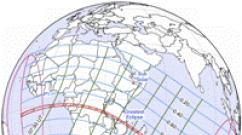Tropical belt animal world. rainforest animals
Jungle, or scientifically, rainforests, from the tops of the trees to the forest floor are filled with life. Found here animals, each of which can be written a separate report: it is a crocodile, anteater, hippopotamus, bat, sloth, koala, chimpanzee, porcupine, gorilla, armadillo. Insects: termites, tropical butterflies, mosquitoes. Tarantulas, hummingbirds and parrots. Hundreds of plant, bird, and animal species thrive in the rainforest.
Select a report about a rainforest inhabitant:
What does "tropics" mean?
The tropics are called forests growing near the equator. These forests are the most important ecosystem of the Earth. The coast of the Gulf of Mexico and Brazil, the South American coasts, the West Indies, part of Africa, the island of Madagascar, and some Asian countries and the Pacific Islands are occupied by tropical thickets. The tropics make up only 6 percent of the land mass.

High humidity and a hot climate are the main features of the fabulous variety of forms of life here. Constant heat, frequent, heavy, short-lived tropical downpours contribute to rapid growth and development of flora. And the fauna, thanks to the abundance of water, also does not suffer from drought. Tropical forests have red or mottled soils, and the forest itself is multi-tiered, and each level is densely populated. Such a variety of flora and fauna is possible due to ideal living conditions.
Who lives in the rainforest and how?
The wilds of the forest are inhabited by a variety of animals. Giant elephants and small insects, birds and animals of medium size, can live simultaneously in one part of the forest, but at different levels, finding themselves in forest areas shelter and food. No other place on land has such a wealth of ancient forms of life - endemics. Due to the dense foliage cover, the undergrowth in the rainforest is weak and animals can move freely.
The variety of animals in the rainforest is amazing: along with reptiles (turtles, crocodiles, lizards and snakes), there are many amphibians. The abundance of food attracts herbivorous animals. They are followed by predators (leopards, tigers, jaguars). The color of the inhabitants of the tropics is saturated, since spots and stripes help to better camouflage in the forest. Many species of ants, tropical butterflies and spiders provide a food base for hundreds of bird species. The tropics are home to the most monkeys on the planet, there are more than one and a half hundred parrots, 700 species of butterflies, including giant ones.

Unfortunately, many representatives of the jungle fauna (antelopes, rhinos, etc.) were exterminated by man during colonialism. Now many animals that used to live freely in tropical forests are left only in nature reserves and zoos. The destruction of forests by man leads to the reduction of fauna and flora, soil erosion, and the loss of the ecological balance of our planet. Tropical forests - the "green lungs of the planet" - have been sending us a message for decades, signaling that a person must be responsible for his actions.
If this message was useful to you, I would be glad to see you
No ecosystem on Earth's land plays such important role like rainforests. From 50 to 75 percent of all species of the planet's fauna live in these territories, and millions more animals remain undiscovered. The amazing biodiversity in these habitats has made them home to some of nature's most interesting creatures.
Jaguar

Jaguars are a real thunderstorm in the rainforests of Central and South America, as they represent the top predators in their family. These are the largest feline of those that inhabit the Americas, and the third largest in the world after tigers and lions. While most cats are known to dislike water, jaguars, like tigers, are an exception. They are perfectly adapted to living in rainforests and feel no worse in the water than on land.
Okapi

This creature resembles a cross between a zebra and an antelope, and is sometimes even mistaken for a unicorn. But the okapi, which has such a unique appearance, is not one of the above creatures. Their closest relatives are giraffes.
These cute and graceful animals live in rainforests. Central Africa. They spend most of their time in the pastures, eating leaves, buds, grass, ferns, and fruit with an unusually long, agile, and sticky tongue. This organ is so dexterous that the animal is able to lick its eyelids, as well as to wash its large ears inside and out.
Amazon river dolphin

The Amazonian river dolphin is one of five living species. river dolphins on the planet, as well as the largest of them. These creatures live in the murky waters of the Amazon and Orinoco basins in South America, and are often seen among the trees of flooded forests. In addition, these dolphins are often called pink, as their skin has a pinkish tint in random places.
glass frog

You are not looking at an x-ray now. The skin of these amazing transparent frogs, which can be seen in the rain forests of Central and South America, is so translucent that you can see the organs through it. It is believed that there are more than 150 species of this amazing family of amphibians in the world.
Cassowary

These multicolored flightless birds, found in the rainforests of New Guinea and Northeast Australia, look like brightly colored ostriches wearing blade-like hats. They are the third largest birds in the world (after ostriches and emus), and unlike many species of birds, females, rather than males, tend to display brighter plumage.
Igrunka

These little monkeys from the rainforests of South America can be considered the most glorious primates in existence. In reality this smallest monkeys in the world. About 22 species are known to exist, and each one exhibits extravagant variations in fluffy attire. Interestingly, they almost always give birth to twins.
Malayan bear

Malayan bear - smallest view bears in the world. It inhabits tropical rainforests South-East Asia. It is one of only two bear species that have adapted to life in the jungle (the other being the South American spectacled bear), and the only species that lives almost exclusively in trees. This creation features a distinctive orange U-shaped collar on the chest.
Anaconda

The anaconda, which lives in the rainforests and floodplains of South America, is the largest, heaviest and second longest snake in the world. This species has earned a secure place in second-rate horror films. Although not venomous, the anaconda is capable of killing an adult male by squeezing, although such attacks are extremely rare. The semi-aquatic lifestyle contributes in part to achieving such enormous size, and this snake is known to be an excellent swimmer.
Siamang

Siamangs are black-haired monkeys native to the forests of Southeast Asia, in fact they are largest species gibbons in the world. They are distinguished by a spherical throat pouch which they use to make loud calls. These sounds are unmistakable from anything else in the dense jungle, and are meant to mark territorial boundaries between rival groups.
fringed turtle

Probably, it is unlikely that in the world you can find a species of turtles with a more strange appearance. Fringed turtles can be seen in the rainforests of the Amazon and Orinoco basins, they lead a sedentary lifestyle and are characterized by a triangular flattened head and shell. Skin patches hang freely from the neck and head of these reptiles, somewhat reminiscent of wet leaves. In reality strange shape From a distance, the fringed turtle's shell resembles a piece of tree bark, which provides the reptile with excellent camouflage.
- one of the most unique natural areas, which have rich fauna and flora and have not been fully explored by scientists. The fauna of the equatorial forests is incredibly diverse; more than 2/3 of all species of animals, birds and insects of our planet live in its various tiers.
The lower tier has become a habitat for rodents and insects. Here is the richest fauna of butterflies and beetles in the world. Under the cover of the forest, you can meet the goliath beetle - one of the heaviest beetles on earth. In the fauna of wet rainforest anteaters, armadillos and sloths, chameleons, spider monkeys, chain-tailed porcupines, the bats(the valley of the Congo and the Amazon has several hundred species), llamas, various orders of birds and birds, as well as reptiles and amphibians. Among amphibians, there are tree frogs that live in trees and lay their eggs in rainwater that accumulates in leaves. The largest snakes in the world are found in the ground tiers, eating rodents, birds, amphibians. In humid equatorial forests live and large predators: jaguars (in South America), leopards (in Africa), crocodiles, hippos. Rivers and lakes contain about 2 thousand fish (about 1/3 of the entire freshwater fauna of the planet).
Consider some of the animals of tropical rainforests in more detail:
Birds
Tropical forests are inhabited by a huge variety of birds, both small and large.
Nectar birds are small birds (from 8 cm in length) with bright and colorful plumage, feeding on the nectar of flowers and contributing to their pollination.

Toucan is a member of the bird family with a huge, brightly colored yellow beak almost equal to the length of his body. It is an object of hunting for local residents due to tasty meat and an orange skin used as a decoration.
Parrots and birds of paradise are among the most densely populated birds in the rainforest. long feathers tails and tufts of multi-colored color.

The world's third largest predatory mammal and one of the largest representatives of the cat family, living in North and South America. Goes hunting at dusk. Its prey are ungulates, birds, monkeys, and also turtles. Jaguar jaws can easily bite through the shell. It swims excellently and in rare cases is able to miss the victim, sometimes it can attack sleeping alligators.
Monkeys
The rainforests are densely populated by gibbons, gorillas, marmosets and narrow-nosed monkeys. They live in forest crowns at a height of 50 m above the ground.

Gorillas are the largest of the representatives of this class. Their growth reaches more than 1.5 m, and weight - up to 260 kg. Predators are afraid to attack them, because adults are very strong.

Gibbons - a distinctive feature is the length of their forelimbs, exceeding the hind limbs. They are well adapted to life in the crowns and foliage of trees and move in a unique way in the animal world by brachiation, swinging from branch to branch with their forelimbs.
The leopard is a large feline, excellent at climbing trunks and branches. It attacks monkeys, small ungulates and is able to drag prey much larger than its own body in weight.

Anaconda is one of the largest boas on earth, its body reaches a length of up to 10 m. The large size of the anaconda allows it to hunt even animals and small mammals, sometimes crocodiles and people. Unlike other snakes, for a long time may be under water. Attacking the victim, he uses a suffocating technique, then gradually swallows it with a huge mouth. Lives up to 50 years and lives in the Amazon forests in South America.
Film. BBC: Planet Earth. Jungle. / BBC: Planet Earth. Jungles.
The author, who is in love with his science - zoogeography, claims and proves that it is as interesting as everything connected with the life of animals in freedom. He talks amazingly about biological properties animals that help them to exist in a certain environment, about the connections of fauna with plant formations, about the distribution of animals around the globe and about the factors limiting their resettlement, about the history of the development of fauna on various continents.
Book:
| <<< Назад
|
Forward >>> |
The sun is high in the sky near the equator all year round. The air is highly saturated with water vapor rising from the damp earth. The seasons of the year are not expressed. It's swelteringly hot.
In such a climate, lush vegetation develops, the most exotic formation of our earth - the tropical forest. Because of big role rains in the formation of this formation, it is also called rain tropical forest.
There are three large areas of tropical forests in the world: in South America they occupy almost the entire huge swimming pool rivers of the Amazon; in Africa they cover the Congo River basin and the coast of the Gulf of Guinea; in Asia, tropical forests occupy part of India, the Indochinese Peninsula, the Malay Peninsula, the Greater and Lesser Sunda Islands, the Philippines and the island of New Guinea.
The rainforest seems fabulous to everyone who first gets into it. Abundance of moisture, mineral salts, optimal temperatures create conditions under which plants form dense thickets, and deep shade makes them stretch upwards, towards the light. It is not for nothing that the tropical forest is known for its huge trees, which raise their crowns high.
Extremely characteristic of the tropical forest are epiphytes, which appear on the trunks and branches of other plants. These include both flowering and many species of ferns, mosses and lichens.
Some epiphytes, such as numerous orchids, draw their nutrients exclusively from the air and rainwater.
Under the canopy of the rainforest there are no grasses, only the rotting remains of leaves, branches and huge trunks of dead trees lie here. This is the kingdom of mushrooms. In conditions of heat and moisture, the decomposition and mineralization of the dead remains of plants and animals proceed rapidly, which determines the high rate of the biological cycle of substances.
If in a deciduous forest temperate climate three or four tiers are quite clearly expressed, then here, in the tropical thickets, we are immediately lost in a multitude of tiers and semi-tiers.
The richness of the flora is stunning. If in European mixed forests there are five to ten species of trees, then here on a hectare of forest there are many times more species than they grow in general throughout Europe. Here you need to spend a lot of time and effort to find at least two identical trees. In Cameroon, for example, there are about 500 tree species and another 800 shrub species.
The wood of trees of the equatorial forest, where seasons are not expressed, does not have rings and is highly valued in industry, for example, ebony (ebony) and mahogany.
At any time of the year, the rainforest blooms and bears fruit. It happens that on the same tree you can simultaneously see buds, flowers, ovaries and ripening fruits. And even if the harvest from one tree is completely harvested, there will always be another nearby, all hung with fruits.
In this amazing environment lives no less wonderful world animals. Air saturated with water vapor allows many invertebrates that usually live in aquatic environment, live here on dry land. For example, Ceylon leeches are widely known (Haemadipsa ceylonica), which stick to the leaves of trees and lie in wait for prey (warm-blooded animals), a number of species of crustaceans, centipedes, and even amphipods.
All invertebrates, whose skin is not covered with a dense chitinous shell, feel really good only in the tropical forest, but in another place they are constantly in danger of drying out. Even an experienced zoologist can hardly imagine how much, for example, gastropods lives in any corner of the rainforest. Only one family Helicarionidae Africa has more species than all the mollusks in all of Poland. Gastropods live everywhere: underground, in fallen trees, on trunks, among branches and leaves, in various tiers of the forest. Even for laying eggs, they do not descend to the ground. Some gastropods of the Philippines (Helicostyla leucophthalma) They build wonderful nests for their eggs from leaves glued together with mucus.
Here ideal conditions for amphibians to live. In tropical forests, there is a huge variety of species of frogs, tree frogs, and toads. Many species lay their eggs in the axils of huge leaves, where water accumulates. Other species lay their eggs directly on the leaves, and their tadpoles undergo accelerated development inside the gelatinous shells of the eggs. There are also species in which the eggs are carried by the male or female on the back. This lasts more than ten days, while in our conditions the caviar would dry out in a few hours.
Insects in the rainforest multiply continuously and live here in huge numbers.
Perhaps it is on the fauna of insects that it is most clearly seen than animal world rainforest is different from tundra. In the tundra, a few species create a billionth population. In tropical thickets, a large zoomass is created due to the abundance of species. In the rainforest, it is much easier to catch a hundred specimens for a collection. various kinds than the same number of members of the same species. A large number of species and a small number of individuals are the main feature of both the flora and fauna of the tropical rain forest. For example, on the island of Barro Colorado in the Panama Canal, as a result of many years of research, about 20 thousand species of insects were discovered on several square kilometers, while in some European country the number of insect species reaches only two to three thousand.
In this variety, the most fantastic appearance animals. Tropical forests are the birthplace of all praying mantises that imitate tree knots, leaf-like butterflies, wasp flies and other artfully camouflaged species.
Wasps and bumblebees form permanent swarms, living in huge and continuously growing nests. Ants and termites are as common in the rainforests as they are in the savannas. There are many predators among ants, for example, the famous Brazilian ants (Ecitony) not building anthills and migrating in a continuous avalanche. On their way, they kill and devour any animal they meet. They can create a kind of nest from own bodies, huddled in a tight ball. In the tropics, anthills or termite mounds are rarely found on the ground. Usually they are located high - in hollows, in twisted leaves and inside the stems of plants.
The year-round abundance of flowers explains why birds live only in the tropics, feeding exclusively on nectar or small insects found in flower calyxes. These are two families: hummingbirds of South America (Trochilidae) and African-Asian sunbirds (Nectariniidae). Similarly, butterflies: in the rainforest they fly by the thousands throughout the year.
![]()
The continuously ripening fruits serve as food for many groups of frugivorous animals typical of the tropics. Among the birds, the most numerous are parrots, large-billed American toucans (Rhamphastidae) and hornbills (Bucerotidae), which are replacing them in Africa; and in Asia - turaco (Musophagidae) with bright plumage and many others leading a similar lifestyle. Dozens of species of monkeys compete with birds. Fruit eaters spend their lives in the crowns of trees, in the upper tiers of the forest. Large fruit-eating bats are characteristic here. (Megachiroptera)- flying dogs and flying foxes.
In a tropical forest, the higher the tier, the more life.
The arboreal lifestyle is typical of many rainforest animal species. In this regard, small-sized animals predominate here. So, various small monkeys - macaques and monkeys - live in trees, and a large gorilla (up to 200 kilograms in weight) is terrestrial, while chimpanzees, which are of medium size, lead a terrestrial-arboreal lifestyle.
Of the three Brazilian anteaters, the smallest is the pygmy anteater. (Cyclopes didactylus) leads an arboreal lifestyle, and a large anteater (Myrmecophaga jubata)- An exclusively terrestrial animal. The average anteater is tamandua (Tamandua tetradactyla) awkwardly moves both on the ground and along the branches and gets food here and there.
![]()
Everyone is familiar tree frog tree frog (Hyla arborea) which, thanks to the suction cups on the fingers, feels confident both on the branches and on the smooth surface of the leaf. In the tropics, tree frogs are extremely widespread. But not only they have suction cups on their fingers. Frogs of three other families also have them: real frogs (Ranidae), copepod frogs (Rhacophoridae) and whistlers (Leptodactylidae). Toes with suction cups also have Indonesian tarsier (Tarsius) tree porcupines and some bats from different parts lights: from America (Thyroptera), Asia (Tylonycteris) and from Madagascar (Myzopoda). When moving along the branches, the most reliable thing is to grab the branch on both sides like ticks. Monkey palms and feet good but not the best best device of this type. It is better if half of the fingers wrap around the branch on one side, and the other fingers on the other side. This is how the paws of the African grasping frog are arranged. (Chiromantis), in some lizards and chameleons. Birds climbing trees - woodpeckers, toucans, parrots and some cuckoos - have two fingers turned forward and two back. Tenacious paws and suckers do not exhaust all possible adaptations for moving through trees. american sloth (bradypus)- this is another fruit-and leaf-eating animal that lives in the crowns. Elongated, hook-shaped claws allow him to hang in the thick of the branches without expending effort. Even dead, the sloth does not fall to the ground, and its remains hang on the tree for a long time until the skeleton crumbles into separate bones. Climbing parrots use their large hooked beak to cling to tree branches like a claw.
Many animals use a spirally coiled tail for clinging. Chameleons, some lizards and mammals use this "fifth paw". American monkeys: howler monkeys (Alouatta), capuchins (Cebus) coats (Ateles), woolly monkeys (Lagothrix), as well as American tree porcupines (Erethizontidae) great use of the tail when climbing.
Another way of arboreal movement is used by Asian gibbons. (Hylobatidae). The animal, strongly swinging on one arm, flies forward and clings to another branch, then again swings like a pendulum and again flies to the next branch. These jumps sometimes reach 10–20 meters. With this movement, the legs do not work at all, and therefore in gibbons they are short and weak. But the arms are very long and strong: after all, what longer arm, the stronger the range. The palms themselves have undergone corresponding changes: thumb small and almost never used, and the other four fingers are unusually elongated. These fingers form something like a movable hook, which can catch on a flashing branch when jumping.
Tropical birds are bad flyers. Both parrots and toucans are slow-flyers, but they are able to maneuver well in a complex weave of branches. Nowhere in the world are there so many gliding animals, a kind of "paratroopers", as in the rainforest. There's a flying frog here (Rhacophorus), making multi-meter jumps, during which she soars with the help of huge membranes, a flying lizard (Draco volans) in which the protruding processes of the ribs are connected by skin used for soaring. flying squirrels (Sciuridae), dormouse (Aliridae) and some other animals glide on the skin stretched between the limbs. When jumping, the front legs are stretched far forward and to the sides, and the hind legs are pulled back, while the skin is stretched, increasing the bearing surface. A flying cat also uses gliding flight (Cynocephalus ) - strange creature, from the order of woolly wings, or kaguans (Dermoptera), somewhat similar to a lemur and partly to insectivorous mammals tropical forests of Indochina, Indonesia and the Philippines.

In the dense thickets of the tropical rainforest, orientation becomes a serious problem. Here, in front of a dense wall of trees, vines and other plants, vision is powerless. In the upper tiers of the forest it is difficult to see anything further than five meters away.
The sense of smell doesn't help much either. The air is still day and night. No wind penetrates the jungle, does not carry smells through the forest. However, the smell of smoldering and the heavy, intoxicating aroma of tropical flowers drowns out any other smell. In such conditions, hearing is most suitable. Small groups of animals wandering in the crowns owe only to hearing that they do not lose each other. Travelers often mention noisy flocks of parrots and monkeys. They are really very noisy, they constantly call to each other, like children picking berries and mushrooms in the forest. But all solitary animals are silent, silent and listen to see if the enemy is approaching. And the enemy silently circles around and listens to see if possible prey rustles somewhere.
Due to the dense tree canopy, the ground is not visible from above; in addition, the earth does not heat up much, and there are no updrafts in the air, so soaring birds of prey are not found in the rainforest.
A huge number of animals inhabit the upper tiers of the rainforest, but at the very "bottom" of it, on earth, life is also in full swing. In addition to numerous invertebrates, ungulates, predators and large anthropoid monkeys live here. It is in vain to look for large deer with spreading horns here: it would simply be difficult for them to move around in the thicket. In forest tropical deer, the antlers are small, often not branched at all. Most antelopes are also small, about the size of a chamois or hare. An example is the pygmy antelope (Neotragus pygmaeus) about 30 centimeters high at the withers, antelopes from the genus Cephalophus, or red chestnut, with light stripes and spots, the size of a chamois bushbuck antelope (Tragelaphus scriptus). Of the large ungulates in the African forest, the bongo antelope lives (Boocercus eurycerus) reddish-chestnut in color, with thin rare vertical stripes and, of course, with small horns.
Or finally okapi Okapia johnstoni - a species first discovered only in 1901 and more or less studied twenty years later. This animal has been a kind of symbol of the secrets of Africa for many years. This distant relative giraffes about the size of a donkey, with a body taller in front than behind, laterally compressed, with a red chestnut body, with black in white stripe feet.
Please note: again a reddish chestnut color with white spots and stripes. This type of protective coloring makes sense only in the depths of the forest, where against the reddish background of decaying vegetation sunlight, breaking through the dense arch of the tropical forest, lays down with white spots and sliding highlights. All these relatively large animals lead a nocturnal, hidden lifestyle. If we meet two animals here at the same time, then this is either a couple, or a mother with a baby. Forest ungulates do not have a herd life. And this is understandable: nothing can be seen in the forest at twenty paces, and herding is losing its protective biological significance.
The elephant is the only animal that passes through the thicket, leaving behind a corridor cut through the living body of the forest. Where a herd of elephants feeds, there is a vast trampled space, like an arena under the arch of untouched huge trees.

Kaffir buffalo lives in the forests of Africa (Syncerus caffer), in Asia - gaur (Bibos gaurus). Both of these species willingly use the paths laid by elephants.
The influence of the rainforest also affected the appearance of elephants and buffaloes. The forest elephant subspecies is undeniably smaller than the savanna elephants, and the forest buffalo is not only smaller than the savanna buffalo, but its horns are disproportionately small.

Just as in the savannah lions are constantly followed by jackals feeding on the remains of lion prey, in the rainforest many animals accompany elephants. Different types of wild boars from the genus Hylochoerus and Potamochoerus perfectly adapted to life in the forest. Low, narrow, with a wedge-shaped forehead, with a powerful snout, they feel great in dense thickets. In places where elephants have knocked down trees or uprooted them, wild boars find edible roots and rhizomes, insect larvae, etc. When the feeding place of elephants is completely dug up by wild boars, herds of forest baboons appear on it. Among them are mandrills-sphinxes (Mandrillus sphinx) with brightly colored snouts and buttocks and smaller black-nosed mandrills (M. leucophaeus) that dig into dug up ground in search of food.

Gorillas and chimpanzees make up a special group of higher anthropoid apes here. The former lead a terrestrial, the latter a terrestrial-arboreal way of life. They move easily in the rainforest, roaming in small groups and feeding on a variety of plant and animal foods.
The rainforest is very rich in animals. There are many different kinds of monkeys living in the Amazon and Orinoco basins. In their structure, they differ from the Old World monkeys living in Africa and India. Old world monkeys are called narrow-nosed, American monkeys are called broad-nosed. A long tenacious tail helps the monkeys deftly climb trees. The spider monkey has a particularly long and tenacious tail. Another monkey, the howler monkey, wraps its tail around the branch and holds it like a hand. Howler was named for its powerful, obnoxious voice.
Most strong predator tropical forest - jaguar. This is a large yellow cat with black spots on the skin. She is good at climbing trees.
America's other big cat is the cougar. It is common in North America to Canada, in South America it is found in the steppes to Patagonia. The cougar is colored yellowish gray and somewhat resembles a lion (without a mane); this is probably why it is called the American lion.
Near reservoirs in the thicket of the forest you can meet an animal that resembles a little horse and even more - a rhinoceros. The animal reaches 2 m in length. His muzzle is elongated, as if elongated into a trunk. This is an American tapir. He, like a pig, loves to wallow in puddles.
On the lakes in the reed beds on the plains of Patagonia and on the mountain slopes of the Andes, the nutria lives - the marsh beaver, or koipu - large rodent the size of our river beaver. The life of a nutria is connected with water. Nutria feeds on succulent roots aquatic plants, arranges nests from reeds and reeds. The animal gives valuable fur. The nutria was transferred to Soviet Union and released in the swampy thickets of Transcaucasia. They have acclimatized and breed well. However, they suffer greatly during the cold winters that occur in Azerbaijan and Armenia, when the lakes freeze.
Unadapted to life in freezing reservoirs, nutria, diving under the ice, do not find a way out. At the same time, their habitats become accessible for jungle cats and jackals, which pass through the ice to nests of nutrias.
Armadillos, sloths and anteaters live in the forests of South America.

The body of the armadillo is covered with a shell, a bit reminiscent of a turtle shield. The shell consists of two layers: inside it is bony, outside - horny - and is divided into belts, movably connected to each other. A giant armadillo lives in Guiana and Brazil. The largest of the armadillos reach one and a half meters in length. Armadillos live in deep burrows and come out to prey only at night. They feed on termites, ants and various small animals.
Sloths have a monkey-like face. The long limbs of these animals are armed with large sickle-shaped claws. They got their name for slowness and slowness. The dull greenish-gray protective coloration of the sloth reliably hides it from the eyes of the enemy in the branches of trees. The color of the sloth is given by green algae that live in its rough and shaggy coat. This is one of the great examples of the cohabitation of animal and plant organisms.
Several species of anteaters are found in the forests of South America. The average anteater is very interesting - tamandua, with a tenacious tail. It runs superbly along sloping trunks and climbs trees, looking for ants and other insects.
Marsupials in the forests of Brazil are eared and water opossums. The water opossum, or swimmer, lives near rivers and lakes. It differs from the eared one in color and swimming membranes on the hind legs.
There are many different types of bats in South America. Among them are blood-sucking leaf-beetles that attack horses and mules, and vampires.
Despite their sinister name, vampires feed exclusively on insects and plant fruits.
Of the birds of great interest is the hoatzin. This is a motley colored, rather large bird with a large crest on its head. The nest of the hoatzin is placed above the water, in the branches of trees or thickets of shrubs. Chicks are not afraid to fall into the water: they swim and dive well. Hoatzin chicks have long claws on the first and second fingers of the wing, which help them climb branches and branches. Curiously, the adult hoatzin loses the ability fast travel by the trees.

Studying the structure and lifestyle of hoatzin chicks, scientists came to the conclusion that the ancestors of birds also climbed trees. After all, the fossil first bird (Archaeopteryx) had long fingers with claws on the wings.
There are over 160 species of parrots in the rainforests of South America. The most famous are green Amazonian parrots. They are good at speaking.
Only in one country - in America - live the smallest birds - hummingbirds. These are unusually bright and beautifully colored fast-flying birds, some of them the size of a bumblebee. There are over 450 species of hummingbirds. They, like insects, hover around flowers, sucking flower juice with a thin beak and tongue. In addition, hummingbirds also feed on small insects.
There are many different snakes and lizards in the rainforests. Among them are boas, or boa, anaconda, reaching 11 m in length, bushmaster - 4 m in length. Many snakes, due to the protective coloration of the skin, are hardly noticeable among the forest greenery.
There are especially many lizards in the tropical rainforest. Big broad-toed geckos are sitting on the trees. Among other species of lizards, the most interesting is the iguana, which lives both in trees and on the ground. This lizard has a very beautiful emerald green color. She eats plant foods.
In the forests of Brazil and Guiana lives a large frog - the Surinamese pipa. It is interesting in a special way of reproduction. The eggs laid by the female are distributed by the male on the back of the female. Each egg falls into a separate cell. In the future, the skin grows, and the cells close. The frogs develop on the back of the female; when they grow up, they leave the cells. Nutrients necessary for frogs during development are transferred from the mother's body blood vessels branching in the walls of skin cells.
In the rivers of tropical America is found big fish - electric eel having special electrical organs. With electric shocks, the eel stuns its prey and scares away its enemies.

In many rivers of South America lives unusually predatory fish- piranha, 30 cm long. In her strong jaws sit sharp, like knives, teeth. If you lower a piece of meat into the river, piranhas immediately appear from the depths and instantly tear it apart. Piranhas feed on fish, attack ducks and domestic animals that inadvertently entered the river. Even such large animals as tapirs suffer from piranha. Fish damage lips drinking water animals. Piranhas are also dangerous to humans.
In tropical forests, the world of insects is diverse. Very large diurnal butterflies are numerous. They are very beautiful and richly colored, varied in shape and size. Brazil has over 700 species diurnal butterflies, and in Europe there are no more than 150 species.
Ants are very numerous. Penetrating into human dwellings, they eat his reserves and thereby cause significant harm. Umbrella ants live in underground galleries. They feed their larvae with mushroom mold, which is grown on finely chopped foliage. Ants bring pieces of leaves to the anthill, moving along strictly constant paths.
There are many spiders in the tropical belt of South America. Among them, the largest is the tarantula. Its size is more than 5 cm. Lizards, frogs, insects serve as food for it; apparently, it also attacks small birds. The same large earthen spiders are found in New Guinea and Java.

Elephants, a variety of monkeys, okapi, an animal related to the giraffe, live in the tropical forests of Africa; in the rivers - hippos and crocodiles. The great apes are the gorillas and chimpanzees. The gorilla is a very large monkey, the growth of males reaches 2 m, weight - 200 kg. They live in the most deaf, inaccessible parts of the rainforest and in the mountains. Gorillas make their lair in trees or on the ground in dense thickets. Gorillas are heavily exterminated by man and are now preserved only in two areas of the tropical forests of Africa - south of Cameroon to the river. Congo and in the country of lakes Victoria and Tanganyika.

Chimpanzees are smaller than gorillas. An adult male is not higher than 1.5 m. They live in families, but sometimes they gather in small herds. Descending from trees, chimpanzees walk on the ground, leaning on their hands clenched into fists.
There are many species of monkeys in the tropical forests of Africa. The fur of these long-tailed little monkeys is greenish in color. Fingerless monkeys (colobus) are interesting, they do not have a thumb on their hands. The most beautiful of these monkeys is the Gverets. She lives in Ethiopia and in the forests to the west of that country. Macaques, related to African monkeys, live in tropical Asia.
Dog-headed monkeys - baboons - are very characteristic of the African continent. They live in the mountains of Africa.
The fauna of Madagascar has some peculiarities. So, for example, lemurs live on this island. Their body is covered with thick fur. Some have fluffy tails. The muzzles of lemurs are more animal than monkey; hence they are called semi-monkeys.
There are many different types of parrots in the rainforests of Africa. The most famous gray parrot is a jaco, which imitates the human voice very well.
Crocodiles have been preserved in large numbers in places. They are especially fond of rivers, the banks of which are overgrown with dense tropical forest. Nile crocodile reaches 7 m in length.
Large, up to 6 m long, boas - pythons live in the forests of Africa.

Among the fish attracts attention lungfish protopterus inhabiting muddy lakes and swamps. These fish, in addition to gills, have lungs that they breathe during a drought. The lungfish lepidosiren lives in South America, and the ceratodes live in Australia.
In the humid dense forests of the islands of Sumatra and Borneo (Kalimantan), the orangutan ape lives. This is a large monkey, covered with coarse red hair. Adult males grow large beards.
Close to the great apes, the gibbon is smaller in size than the orangutan, its body length is 1 m. The gibbon is distinguished by long limbs; with their help, swinging on the branches, he very easily jumps from tree to tree. Gibbons live on the island of Sumatra, on the Malay Peninsula and in the mountain forests of Burma.
A variety of macaques live in the forests of the Greater Sunda Islands - Sumatra and Borneo - and in Eastern India. The nosed monkey lives on the island of Borneo. Her nose is long, almost proboscis-shaped. In older animals, especially in males, the nose is much longer than in young monkeys.
In the forests of India and the nearest big islands often found Indian elephant. Since ancient times, it has been tamed by man and used in various jobs.
The common Indian rhinoceros is well known - the largest one-horned rhinoceros.
In Asia, a relative of American tapirs lives - the black-backed tapir. It reaches 2 m in height. His back is light, and other parts of the body are covered with short black hair.

Among the predators of southern Asia, the most famous Bengal tiger. Most tigers survived in India, Indochina, on the islands of Sumatra and Java.
The tiger is a twilight animal; he hunts for large ungulates. A tiger, in the event of a hunter, illness or headman being wounded by an unsuccessful shot, or in general for any reason who has lost the ability to hunt ungulates that make up his main food, attacks people, becomes a "cannibal".
We have tigers in Transcaucasia, Central Asia, Primorye and in the south of the Ussuri Territory.
The leopard is distributed in southern Asia, in the forests of the Greater Sunda Islands and in Japan. It is found in the Caucasus, in the mountains of Central Asia and in Primorye. We call him a bar. Leopard attacks pets; he is cunning, bold, and dangerous to humans. On the Greater Sunda Islands, black leopards are often found; they are called black panthers.
South Asia is home to the sloth bear and the Malay bear, the biruang. Gubach is a large, heavy beast, armed with long claws, allowing him to climb trees well. The color of his fur is black, on the chest there is a large white spot. Its large lips are mobile, they can be stretched out with a tube, and with a long tongue the bear takes out insects from the cracks of trees. Gubach lives in tropical forests on the peninsula of Hindustan and on the island of Ceylon. It feeds on plants, fruits, berries, insects, bird eggs and small animals.
The Malayan bear has short, black fur. It spends most of its life in trees, feeding on fruits and insects.
There are many birds in tropical Asia. One of the most beautiful is considered a peacock living in the wild in Java, Ceylon and Indochina.
In the forests of the Sunda Islands, in Ceylon and in India, there are banking, or bush, chickens - the wild ancestors of domestic chickens, many species of pheasants and other chickens.
The waters of South Asia are inhabited by long-snouted crocodiles - gharials. They live in r. Ganges.
A snake is found on the Malay Peninsula reticulated python reaching 10 m in length.
There are many in the forests of India poisonous snakes, from the bites of which a large number of people suffer every year. The most dangerous cobra, or spectacled snake. She got her name from the spots on the back of her head that look like glasses.
The tropics are inhabited by many amphibians, or amphibians. Among them is the Javan flying frog. Strongly developed webs between the toes of the front and hind paws allow it to jump from one tree to another when planning.
Having become acquainted with the distribution of animals on the globe, it is easy to see that on different continents similar animals live under similar living conditions. Some species have adapted to life in the tundra, others in the steppes and deserts, and others in the mountains and forests. Each continent has its own fauna - species of animals that live only on this continent. Especially in this regard, the animal world of Australia is peculiar, which we will consider below.
Studying the past of the Earth from the fossil remains of animals that once inhabited the continents and islands, scientists came to the conclusion that the composition of the fauna, that is, the animal world, has continuously changed in all geological epochs. Connections arose between the continents; For example, between Asia and North America there was a connection. Animals that inhabited Asia may have entered the Americas; therefore, in the fauna of America and Asia, we still see a lot of similarities at the present time. The geological history of the Earth helps to clarify some features in the distribution of animals on the continents. Thus, the remains of marsupials are found in the ancient layers of the earth of Europe and America. Nowadays, these marsupials live only in Australia and only a few species in America. Consequently, earlier marsupials on the globe were much more widespread. This confirms the opinion of geologists about the connection that existed between these continents.
Having studied the composition of the animal world of individual continents and islands, scientists have divided Earth into areas characterized by species of animals found only in this area.
The main areas are as follows: Australian, Neotropical (South and Central America), Ethiopian (Africa), Eastern, or Indo-Malayan, Holarctic (Northern Asia, Europe and North America).
If you find an error, please highlight a piece of text and click Ctrl+Enter.













